 Facebook
Facebook
 X
X
 Instagram
Instagram
 TikTok
TikTok
 Youtube
Youtube
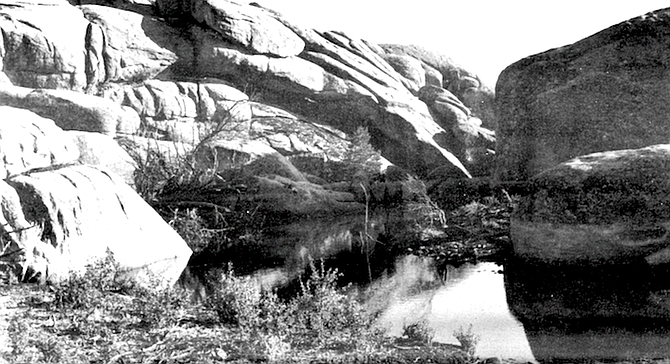
There is something startling about the place called Hakwin: in the midst of this mountain valley, green with manzanita, juniper, and pine, the hundred-foot-high granite ridge looms like an apparition. It is perhaps a half mile long, and less than one hundred feet across; it begins at no particular mountain and connects to nothing. Just a massive wall of boulders stacked here as if by some powerful hand.
We get out of the car, buttoning our coats against the fierce wind.
The trees around us are bouncing and shaking as if possessed, and a ragged mist, white as steam, is sweeping across the valley with astonishing speed. Ken Hedges, who is curator of archaeology at the San Diego Museum of Man, leads the way up the steep granite ridge, hopping from boulder to boulder until we reach the relatively fiat area at the top. In a few more moments we come to a shelter in the rocks, a natural pocket protected from the howling wind. Jumping down into it, we catch our breath and then begin to examine the eerie figures and geometric patterns painted on the rock face in front of us.
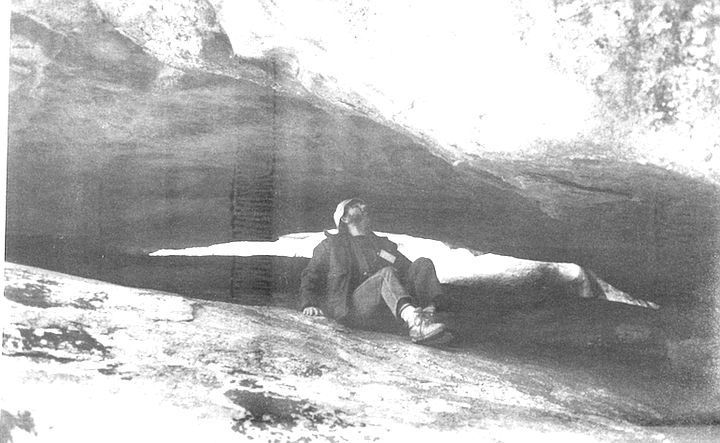
Hakwin (pronounced Ha-queen) is an old Indian site near La Rumorosa in Baja California, a ten-mile crow flight southeastward from Jacumba. Like tribes of hunter-gatherers around the world, the Kumeyaay Indians who once made this area their home favored rocky outcrops, and they often painted figures and symbols on them with pigments made of powdered rock. The meaning of these symbols, and why they were painted, has puzzled scientists for a long time. Some have suggested that the paintings were a kind of “hunting magic,” a plea to the gods for plentiful game for the tribe; others have theorized that the paintings represent important characters or incidents in a tribe’s mythology. But the explanation increasingly favored by most experts, including Hedges, is that most of the paintings were made by Indian shamans, or holy men, and were associated with complex rituals. The paintings are literally the last remnants of a primitive religion. Hedges says, a shadowy forerunner of such great beliefs as Buddhism and Christianity that now, along with the hunter-gatherer peoples who once practiced it, has virtually disappeared from the face of the earth.
“In shamanism, we have the basic religious techniques of mankind,’’ explains Hedges. “You don’t have a church, you don’t have a priest, you don't have an organized dogma; what you do have is an individual — a shaman — who intercedes with the supernatural on behalf of his people.’’ The Indians believed that all things contained supernatural power, and that it was important to control that power for the good of the tribe. Shamans performed rituals to end droughts or floods, to banish illnesses, sometimes even to predict the future. They undertook “vision quests,” a search for a vision at a crucial time. A shaman on a vision quest might have been trying to attain power over someone or something; or he might have been seeking an animal “helper,” a spirit in animal form that would advise him and carry his messages to other spirits of the supernatural world. “When Moses went to the mountaintop to talk to God — that’s exactly like something a shaman might have done,” says Hedges.

The shamans sought out places like Hakwin to communicate with spirits because the very strangeness of such places was evidence of power, of the connection to another world. Pointing out the weird rock forms around us and the sparkling mica in the boulders nearby. Hedges says that Hakwin was a place where the Kumeyaay “could come and tap into supernatural power — which is what people are doing in a cathedral, by the way.”
The wind rattles a stunted juniper in the rocks above us; overhead a pale sun gleams through the glowing mist. A large Indian camp once stood at the south end of Hakwin, and the ridge itself is riddled with crevices and caves, many of them painted with shamans’ symbols. The place has the feel of a huge temple, and more than that it has a vague presence that is elusive and almost indefinable but very real. Hedges speaks of the feeling he often gets at rock art sites of something that is about to happen, something that never quite does.
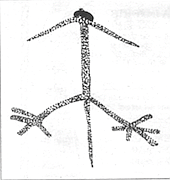
The symbols themselves probably have a lot to do with this feeling.
The “hunting magic” theory advanced by earlier investigators as an explanation of rock art is given the lie here in Kumeyaay country, where almost no representations of animals exist. At Hakwin, as at most Kumeyaay rock art sites, the paintings are far more esoteric — here a sticklike human figure, there a small red handprint. Diamondshaped patterns are interspersed with spirals, dots, and wavy lines, and on one rock a black manlike figure with its head surrounded by a homed red circle seems to glare out defiantly. Hardly a plea for more plentiful game; according to Hedges, these are images from another world.
Hedges and a lot of other experts believe that the symbols painted on the rock are visions that the shamans saw while in a state of trance. “The shaman intercedes with the supernatural world by going into the ecstatic trance,” he explains firmly. “At some distant point in man’s past, you have the idea developing that you have to get into what’s nowadays called an altered state of consciousness, a separate reality, to see the supernatural world that always exists parallel to ours. You can do this by hypnosis, by fasting, by meditating, by singing and chanting endlessly. Or you can do it through ingesting hallucinogenic substances. Hallucinogens happen to be one of the basic ways that shamans achieve trance states, but they’re not the only way.”
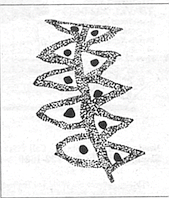
Nevertheless, the potent chemicals extracted from plants were an important tool for shamans throughout North and South America. In Kumeyaay country (which extended eastward from the coast to the Imperial sand dunes, and southward from the San Diego River drainage to Ensenada), the only available hallucinogen was datura, or jimson weed, a plant whose delicate, pale white blossom belies the strength of the chemicals locked inside. The precise preparation of datura in connection with rock art is unknown, but Hedges thinks it was probably similar to the way the plant was prepared for the toloache ceremony, in which boys were initiated into the tribe as adults. For that ceremony, Indian shamans would first find a datura plant whose roots grew in one of the sacred directions, usually north or east. North was the direction in which the dead go; east was where the sun came from, the source of power and life to the Kumeyaay. The shamans would grind the roots in a stone mortar and steep the pulp in water, and then the Filtered brew would be gulped down. The resulting journey was not undertaken whimsically; the amount of datura needed to stimulate hallucinations and visions is roughly equivalent to the amount needed to kill a healthy human being. Hedges recalls that when he was a student at San Diego’s Mount Miguel High School in 1960, two teenage boys in Ojai who sampled datura were found on that town’s main street at night.
In a state of mind that could only be called extremely deranged, they were walking from streetlight to streetlight, banging their heads on each pole until they were covered with blood. Even among Indians, terrifying visions and sometimes death were the result for those who submitted themselves to the plant’s power. But in the latter case. Hedges points out, “the reason for death was not [considered to be] the plant’s fault. . . . It was the [individual’s] fault, for not being properly prepared.”
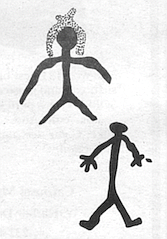
The influence of datura would help to explain many of the symbols commonly found in Kumeyaay rock art, particularly the geometric ones found at sites such as Hakwin. The strange diamond patterns, dots, and wavy lines could be visions seen while under the influence of the plant. Hedges has noted the similarity of many of these designs to phosphenes, the patterns seen when you press on your eyeballs or close your eyes suddenly in a bright room, and several experiments conducted in the 1960s in the United States and West Germany proved that hallucinogenic drugs increase the intensity of phosphenes seen. Many basic phosphenes are seen over and over by nearly everyone, and lists of these commonly recurring patterns that have been published over the last twenty years look like virtual catalogues of rock art. In addition, at least two tribes of New World Indians, the Huichol of central Mexico and the Tukano of Colombia, have told researchers that the striking patterns in their weavings and paintings are reproductions of visions they have seen after ingesting hallucinogenic plants. Pointing to a painting on the rock in front of us, a spiral surrounded by dots, with radiating lines coming out of the center, Hedges comments, “You couldn’t pick a better single design for an example of a phosphene. It looks like it’s radiating, pulsating. When I look at these [symbols] I see a lot of movement, even though they’re stationary.
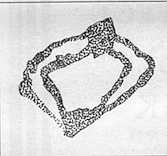
“Whether you interpret images like this as being in your mind, as modem psychology and medicine would, or whether you interpret them as images of another world that you normally can’t see, which is the traditional [Indian] way of interpreting them, really doesn’t matter. The point is, they are that other world. They certainly aren’t of this world.”
The wind swirls, the mist sails by overhead, the trees in the valley below toss and bow their heads. The croak of an unseen raven drifts across the rocks — a message, perhaps, intended for other ears. A shaman emerging from a trance might have painted these symbols we are now standing near, perhaps to record his journey to the spirit world or perhaps, as Hedges believes, to help communicate his experience to the rest of the tribe. “It’s important for them to know not only that you’ve been there, but what you perceived there, what you did on their behalf. . .
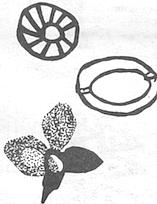
Hedges estimates that the paintings we are looking at are less than 500 years old. There is no way to date them precisely, but other paintings in a rock shelter nearby are much fainter, and the assumption is that they are probably older. A Kumeyaay woman from Manzanita, who died in the 1930s at the age of seventy, recalled before her death that shamans had painted rocks in her lifetime, so it is known that the early religion persisted at least until then. But Hedges says that as Indian culture disintegrated under the relentless expansion of the white settlers, Kumeyaay elders would not have taught the old ways as much, and the art of communicating with spirits and painting the rocks would have died with those who practiced it. “I think the old-time religious leaders were gone a long time ago,” he says, squinting against the wind.
However old they are. though, the paintings at Hakwin were done in a relatively short time span, by a limited group of shamans or perhaps even one individual, according to Hedges. All of the symbols are stylistically similar, he points out, and the way they are positioned on the rock face suggests a deliberate arrangement, as if the creator of these paintings had a master plan in mind for the entire “panel.” The meaning of the red handprints is unknown, but around the world the handprint is often interpreted as a sort of signature, a sign that you were at the site. “This place is like a shrine,” Hedges observes quietly. “A shrine is a holy place where you go to leave something and offer a prayer. Whether you leave an offering for God or for the spirit that lives in the rock, you’re still interacting with the supernatural world.”
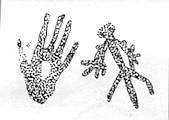
The wind brings a light rain, fine as ocean spray, to our cheeks, and with it numbing cold. Hedges leads the way out of the rock shelter and down the far side of the granite ridge, where we must squeeze through a narrow channel in the rock before we come to the flat ground at the base of Hakwin. The ghostly silhouettes of nearby mountains surround us in the mist, and the wind whistles across the valley, tearing at our clothes and occasionally almost neutralizing our attempts to step forward. We make our way around the southern tip of Hakwin, where Hedges points out stone flakes and bits of pottery that litter the ground. The shamans of the Kumeyaay apparently felt no need to journey to the distant wilderness to communicate with their time-honored gods; like a church, Hakwin was located near the dwellings of its people.
As we reach the other side of the ridge and start back toward our car, the sun suddenly breaks through the clouds, and a small bird, a rock wren, appears at the base of Hakwin. The wren hops up onto a prominent boulder, and for a moment seems to be sizing us up. But the bird remains silent, as if it were thinking of saying something and then thought better of it. There is power still at Hakwin, but it is power of an ancient, subtle kind, and we modem people have lost touch with it.


There is something startling about the place called Hakwin: in the midst of this mountain valley, green with manzanita, juniper, and pine, the hundred-foot-high granite ridge looms like an apparition. It is perhaps a half mile long, and less than one hundred feet across; it begins at no particular mountain and connects to nothing. Just a massive wall of boulders stacked here as if by some powerful hand.
We get out of the car, buttoning our coats against the fierce wind.
The trees around us are bouncing and shaking as if possessed, and a ragged mist, white as steam, is sweeping across the valley with astonishing speed. Ken Hedges, who is curator of archaeology at the San Diego Museum of Man, leads the way up the steep granite ridge, hopping from boulder to boulder until we reach the relatively fiat area at the top. In a few more moments we come to a shelter in the rocks, a natural pocket protected from the howling wind. Jumping down into it, we catch our breath and then begin to examine the eerie figures and geometric patterns painted on the rock face in front of us.

Hakwin (pronounced Ha-queen) is an old Indian site near La Rumorosa in Baja California, a ten-mile crow flight southeastward from Jacumba. Like tribes of hunter-gatherers around the world, the Kumeyaay Indians who once made this area their home favored rocky outcrops, and they often painted figures and symbols on them with pigments made of powdered rock. The meaning of these symbols, and why they were painted, has puzzled scientists for a long time. Some have suggested that the paintings were a kind of “hunting magic,” a plea to the gods for plentiful game for the tribe; others have theorized that the paintings represent important characters or incidents in a tribe’s mythology. But the explanation increasingly favored by most experts, including Hedges, is that most of the paintings were made by Indian shamans, or holy men, and were associated with complex rituals. The paintings are literally the last remnants of a primitive religion. Hedges says, a shadowy forerunner of such great beliefs as Buddhism and Christianity that now, along with the hunter-gatherer peoples who once practiced it, has virtually disappeared from the face of the earth.
“In shamanism, we have the basic religious techniques of mankind,’’ explains Hedges. “You don’t have a church, you don’t have a priest, you don't have an organized dogma; what you do have is an individual — a shaman — who intercedes with the supernatural on behalf of his people.’’ The Indians believed that all things contained supernatural power, and that it was important to control that power for the good of the tribe. Shamans performed rituals to end droughts or floods, to banish illnesses, sometimes even to predict the future. They undertook “vision quests,” a search for a vision at a crucial time. A shaman on a vision quest might have been trying to attain power over someone or something; or he might have been seeking an animal “helper,” a spirit in animal form that would advise him and carry his messages to other spirits of the supernatural world. “When Moses went to the mountaintop to talk to God — that’s exactly like something a shaman might have done,” says Hedges.

The shamans sought out places like Hakwin to communicate with spirits because the very strangeness of such places was evidence of power, of the connection to another world. Pointing out the weird rock forms around us and the sparkling mica in the boulders nearby. Hedges says that Hakwin was a place where the Kumeyaay “could come and tap into supernatural power — which is what people are doing in a cathedral, by the way.”
The wind rattles a stunted juniper in the rocks above us; overhead a pale sun gleams through the glowing mist. A large Indian camp once stood at the south end of Hakwin, and the ridge itself is riddled with crevices and caves, many of them painted with shamans’ symbols. The place has the feel of a huge temple, and more than that it has a vague presence that is elusive and almost indefinable but very real. Hedges speaks of the feeling he often gets at rock art sites of something that is about to happen, something that never quite does.

The symbols themselves probably have a lot to do with this feeling.
The “hunting magic” theory advanced by earlier investigators as an explanation of rock art is given the lie here in Kumeyaay country, where almost no representations of animals exist. At Hakwin, as at most Kumeyaay rock art sites, the paintings are far more esoteric — here a sticklike human figure, there a small red handprint. Diamondshaped patterns are interspersed with spirals, dots, and wavy lines, and on one rock a black manlike figure with its head surrounded by a homed red circle seems to glare out defiantly. Hardly a plea for more plentiful game; according to Hedges, these are images from another world.
Hedges and a lot of other experts believe that the symbols painted on the rock are visions that the shamans saw while in a state of trance. “The shaman intercedes with the supernatural world by going into the ecstatic trance,” he explains firmly. “At some distant point in man’s past, you have the idea developing that you have to get into what’s nowadays called an altered state of consciousness, a separate reality, to see the supernatural world that always exists parallel to ours. You can do this by hypnosis, by fasting, by meditating, by singing and chanting endlessly. Or you can do it through ingesting hallucinogenic substances. Hallucinogens happen to be one of the basic ways that shamans achieve trance states, but they’re not the only way.”

Nevertheless, the potent chemicals extracted from plants were an important tool for shamans throughout North and South America. In Kumeyaay country (which extended eastward from the coast to the Imperial sand dunes, and southward from the San Diego River drainage to Ensenada), the only available hallucinogen was datura, or jimson weed, a plant whose delicate, pale white blossom belies the strength of the chemicals locked inside. The precise preparation of datura in connection with rock art is unknown, but Hedges thinks it was probably similar to the way the plant was prepared for the toloache ceremony, in which boys were initiated into the tribe as adults. For that ceremony, Indian shamans would first find a datura plant whose roots grew in one of the sacred directions, usually north or east. North was the direction in which the dead go; east was where the sun came from, the source of power and life to the Kumeyaay. The shamans would grind the roots in a stone mortar and steep the pulp in water, and then the Filtered brew would be gulped down. The resulting journey was not undertaken whimsically; the amount of datura needed to stimulate hallucinations and visions is roughly equivalent to the amount needed to kill a healthy human being. Hedges recalls that when he was a student at San Diego’s Mount Miguel High School in 1960, two teenage boys in Ojai who sampled datura were found on that town’s main street at night.
In a state of mind that could only be called extremely deranged, they were walking from streetlight to streetlight, banging their heads on each pole until they were covered with blood. Even among Indians, terrifying visions and sometimes death were the result for those who submitted themselves to the plant’s power. But in the latter case. Hedges points out, “the reason for death was not [considered to be] the plant’s fault. . . . It was the [individual’s] fault, for not being properly prepared.”

The influence of datura would help to explain many of the symbols commonly found in Kumeyaay rock art, particularly the geometric ones found at sites such as Hakwin. The strange diamond patterns, dots, and wavy lines could be visions seen while under the influence of the plant. Hedges has noted the similarity of many of these designs to phosphenes, the patterns seen when you press on your eyeballs or close your eyes suddenly in a bright room, and several experiments conducted in the 1960s in the United States and West Germany proved that hallucinogenic drugs increase the intensity of phosphenes seen. Many basic phosphenes are seen over and over by nearly everyone, and lists of these commonly recurring patterns that have been published over the last twenty years look like virtual catalogues of rock art. In addition, at least two tribes of New World Indians, the Huichol of central Mexico and the Tukano of Colombia, have told researchers that the striking patterns in their weavings and paintings are reproductions of visions they have seen after ingesting hallucinogenic plants. Pointing to a painting on the rock in front of us, a spiral surrounded by dots, with radiating lines coming out of the center, Hedges comments, “You couldn’t pick a better single design for an example of a phosphene. It looks like it’s radiating, pulsating. When I look at these [symbols] I see a lot of movement, even though they’re stationary.

“Whether you interpret images like this as being in your mind, as modem psychology and medicine would, or whether you interpret them as images of another world that you normally can’t see, which is the traditional [Indian] way of interpreting them, really doesn’t matter. The point is, they are that other world. They certainly aren’t of this world.”
The wind swirls, the mist sails by overhead, the trees in the valley below toss and bow their heads. The croak of an unseen raven drifts across the rocks — a message, perhaps, intended for other ears. A shaman emerging from a trance might have painted these symbols we are now standing near, perhaps to record his journey to the spirit world or perhaps, as Hedges believes, to help communicate his experience to the rest of the tribe. “It’s important for them to know not only that you’ve been there, but what you perceived there, what you did on their behalf. . .

Hedges estimates that the paintings we are looking at are less than 500 years old. There is no way to date them precisely, but other paintings in a rock shelter nearby are much fainter, and the assumption is that they are probably older. A Kumeyaay woman from Manzanita, who died in the 1930s at the age of seventy, recalled before her death that shamans had painted rocks in her lifetime, so it is known that the early religion persisted at least until then. But Hedges says that as Indian culture disintegrated under the relentless expansion of the white settlers, Kumeyaay elders would not have taught the old ways as much, and the art of communicating with spirits and painting the rocks would have died with those who practiced it. “I think the old-time religious leaders were gone a long time ago,” he says, squinting against the wind.
However old they are. though, the paintings at Hakwin were done in a relatively short time span, by a limited group of shamans or perhaps even one individual, according to Hedges. All of the symbols are stylistically similar, he points out, and the way they are positioned on the rock face suggests a deliberate arrangement, as if the creator of these paintings had a master plan in mind for the entire “panel.” The meaning of the red handprints is unknown, but around the world the handprint is often interpreted as a sort of signature, a sign that you were at the site. “This place is like a shrine,” Hedges observes quietly. “A shrine is a holy place where you go to leave something and offer a prayer. Whether you leave an offering for God or for the spirit that lives in the rock, you’re still interacting with the supernatural world.”

The wind brings a light rain, fine as ocean spray, to our cheeks, and with it numbing cold. Hedges leads the way out of the rock shelter and down the far side of the granite ridge, where we must squeeze through a narrow channel in the rock before we come to the flat ground at the base of Hakwin. The ghostly silhouettes of nearby mountains surround us in the mist, and the wind whistles across the valley, tearing at our clothes and occasionally almost neutralizing our attempts to step forward. We make our way around the southern tip of Hakwin, where Hedges points out stone flakes and bits of pottery that litter the ground. The shamans of the Kumeyaay apparently felt no need to journey to the distant wilderness to communicate with their time-honored gods; like a church, Hakwin was located near the dwellings of its people.
As we reach the other side of the ridge and start back toward our car, the sun suddenly breaks through the clouds, and a small bird, a rock wren, appears at the base of Hakwin. The wren hops up onto a prominent boulder, and for a moment seems to be sizing us up. But the bird remains silent, as if it were thinking of saying something and then thought better of it. There is power still at Hakwin, but it is power of an ancient, subtle kind, and we modem people have lost touch with it.
Comments